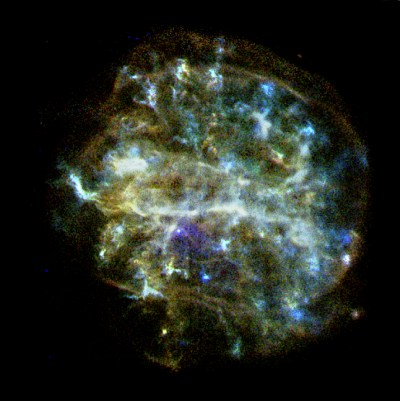VIEW: Heavy Elements in Stars Today
Heavy Elements in Stars Today

All liquids, gases, and solids found on our planet are made from one or more of 92 naturally occurring elements. From what they have observed, scientists have determined that these same 92 elements are found throughout our universe. This suggests that a common process leads to their creation. But how are these elements created? How did they get they widely spread across the universe?
Currently, the most popular theory states that the nuclei of hydrogen and helium, the lightest and most abundant elements in the visible universe, were created in the moments following the Big Bang. All other naturally occurring elements were — and continue to be — generated in the high temperature and pressure conditions present in stars. Under these conditions, the nucleus of one element can fuse with the nucleus of a different element, creating the nucleus of a heavier element. When elements lighter than iron form, the mass of the new nucleus is less than the combined mass of the two original nuclei. The difference in mass between the two is released as energy. In stars, this kind of reaction is referred to as nucleosynthesis (nuclear fusion). Stars are fueled by nuclear fusion reactions, which take place in their cores.
Every time scientists measure light from a star they get a distinct pattern of dark absorption bands in the color spectrum. This pattern shows what kind of heavy elements make up a star because these spectral lines are unique for each element: No two elements produce the same colors and line positions along a spectrum. By using instrumentation that reads light signatures from far away — a technique known as spectroscopy — scientists today know with great certainty which elements a planet or a star, or even a star's dispersed remnants, contains. Also, scientists are beginning to detect "neutrinos" from other stars. Neutrinos are formed when elements (such as hydrogen and helium fuse); this helps prove nucleosyntheisis is taking place inside stars. With these pieces of evidence scientists are confident that heavy elements exist in stars today.
The following video shows how scientists study light emissions from exploding stars, called supernovas. Their observations and analysis can tell us the origin of the elements found on Earth and throughout the universe.
Sources http://schools.utah.gov/curr/science/core/earth/sciber9/Stand_1/html/2d.htm (fair use) and Teachers' Domain, The Origin of the Elements, published January 22, 2004, retrieved on July 14, 2010, http://www.teachersdomain.org/resource/phy03.sci.phys.matter.origin/